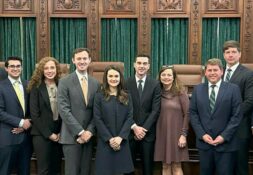Tim Bradley, Staff Writer
The Mendoza College of Business hosted two Notre Dame Alumni on January 29 for a panel discussion on “Measuring and Getting Results in Non-Profits.” The lecture, which was moderated by Marc Hardy (Director, Nonprofit Executive Education, Notre Dame), was part of the “Making a Living Making a Difference” discussion series.
Hardy introduced Dan Morrison, the CEO and Founder of Citizen Effect, and Angela Smith Cobb, the Director of the New Options Project at ROI Ventures, to “address a topic that is rapidly gaining attention in the non-profit sphere” – measuring and getting results in non-profits. More and more pressure is on non-profits by donors and the public to explain their business models and how they are using their money.
Morrison spoke first and began by giving a brief history of his post-college work experience. He first worked for a for-profit firm and loved the experience. Simply put, he was working in Japan, making good money and meeting cool people. At the same time, Morrison recognized that the work he was doing did not have anything to do with his beliefs and virtues. As a result, he decided to enroll in graduate school to broaden his horizons. He also visited India and spent some time with the “poorest of the poor” through The Self-Employed Women’s Association of India (SEWA), a trade union for poor, self-employed women workers. During this time Morrison partnered with a woman through SEWA to install a well in a rural village. In many of these villages, women spend several days every month walking miles to fetch water. He described how something as simple as installing a water well could transform the lives of people of the village.
Perhaps unsurprisingly, this time marked a pivot point in Morrison’s life. He discovered the “desire to become a platform for people to connect with communities in need, through funding or service.” Thus, Citizen Effect was born. The organization is Morrison’s non-profit company and is dedicated to projects such as the one that he completed during his days working with SEWA.
“Like the typical entrepreneur, I didn’t care about measurement or impact at first,” said Morrison. “You do everything based on passion, not metrics and measurements.” But, as Morrison quickly learned from talking with potential investors, it is important to have a solid grasp of what impact you are making in your market. This impact comes on two levels: mission impact – impact on people – and business impact – earned revenue, donations, etc. Morrison knew very clearly what impact he was looking for on the mission side and how much money he needed to supply to positively impact the community in terms of employment, amenities and education.
The trickier side turned out to be the business impact side. Investors demand a very clear business model and plan, and because Citizen Effect emphasized the mission side more than the business side, the company struggled. Despite having impacted tens of thousands of lives, Morrison feels Citizen Effect has thus far come up short of its expectations. The question is whether the mission concept or the business model is responsible for the organization not reaching its goal. The challenge all non-profits face is finding the balance between business and social impact. Many non-profits would love to focus only on helping people; however, the reality is that running an efficient non-profit is comparable to operating a successful business.
Smith Cobb offered an additional perspective to Morrision’s wisdom. She stressed that when one works in non-profits, “You are always in the mindset of your mission. Despite this you have financial responsibilities.” This is where the clash between business and heart can come into play. The pressure is always there to measure results by scale. Smith Cobb stressed that the New Options Project is not focused on scale – that is, how many people they are impacting. She focuses on providing a more efficient marketplace for young adults who are at a disadvantage for gaining employment, and helping these young people connect to employment pathways. “Getting them that first job is not success; we want to get them on the pathway to advancement.”
The New Options project group examines influence rather than scale. Signs of success for them include their ideas permeating other companies in the market and employers changing their perceptions of the disadvantaged young adults seeking work. Smith Cobb summed up her beliefs on measuring and getting results in her work: “First, we as innovators at non-profits must recognize what we need to measure. Second, we should focus on measurement of outcomes rather than impact. This is a really good moment for all of us to be thinking about our motives and our work, because that is what will help us to reach our ultimate goal – change.”
Smith Cobb described situations where the head and the heart can come together to further the cause of non-profits. When selling an idea to investors, you cannot simply rely on quantifiable aspects; the core of non-profit success lies in the qualitative aspect. Some things in this world cannot be measured and are not tangible. When pitching to investors, Smith Cobb said that it is important to “paint a holistic picture. It is all about knowing the market but with a qualitative aspect. Stories illustrate the data, and in this way you create a story.” Morrison added, “Don’t just rattle [the data] off; you have to tell a story” to attract investors. It comes down to appealing to our humanity.
In closing, both Morrison and Smith Cobb emphasized the economic necessity of non-profit firms. The reason most of these firms are non-profit is that their true desire to help and to cause change – and also because the markets they serve do not offer the possibility of turning a profit. Otherwise some for-profit firm would have entered the market. Non-profits do what they do despite the financial difficulty of working in these markets – they do these things out of love. Their main goal is not to give money but to give tools to allow people to make their lives better. Smith Cobb concluded, “There is an important message in the blend of head and heart. It’s up to us to be the ones who fuse the ideas of head and heart, always keeping the core mission goal at the center of the work. When we get the pressure to forget about the human side, we have to rebel and preach the gospel of the heart and the head.”
Tim Bradley is a freshman majoring in economics and theology. To learn more, contact him at tbradle5@nd.edu.






Leave a Reply